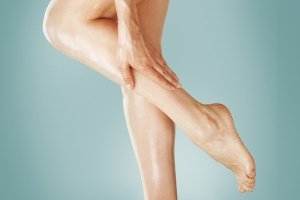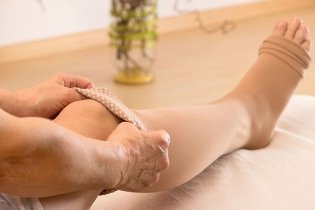Varicose veins - a disease associated with the increase, the deformation, as well as the education of the nodes of the veins close to the surface of the body. More often seen in the feet.

The disease is observed that 20% of women and 10% of men all over the world. This disease in its early stages, rarely cares for the sick, but that hides a huge danger to the life, as at any time you can produce thrombophlebitis. Blood clots that form in veins can not be separated and move with the blood flow to the vital organs and cause the death of the person.
Varicose veins are caused by weakness of the wall and the valve of a sick system. Ok this is the system that allows the circulation of the blood through the veins of the legs to the heart, but in case of violation of operation of the valves takes place by the stagnation of blood in the legs and increased the pressure. In the end, vienna will become larger, weak, and your form is broken.
Often varicose veins suffer people who have a genetic predisposition. In addition, the risk of developing the disease increases in people who are overweight, pregnant women, as well as the people who spend a lot of time standing. The main factor of disease development - the process of aging of the organism.
The symptoms of the
The disease has two forms (primary and secondary).
The primary form of the disease is related to the weakness or violation of the venous wall. Factors that cause this disease are pregnancy, obesity, congenital weakness of the connective tissue, long stay in standing up to the situation, and also the use of stockings with tight elastic bands.
The symptoms of the primary forms of varicose veins:
- the tiredness, the heaviness, pain and burning sensation in legs;
- itching in the area of the vessels;
- swelling of the ankles or feet.
High school in the form of varicose veins occurs as a result of a violation of the venous reflux, as well as in lesions and tumors.
The symptoms of the disease in this form are:
- swelling of the legs and calves after long time standing or sitting;
- the pain in the feet and in the calf of the leg;
- skin abnormalities (increased dryness, change in skin color, decrease of the thickness of the epidermis);
- night cramps in the legs;
- ulcers trophic.
Causes of varicose veins of the legs are:
- weakness inherited from the vessel;
- the sedentary lifestyle;
- long static load;
- hormonal disorders and receipt of the hormonal drugs;
- injuries of the feet;
- pregnancy;
- the elevation of the severity of the overload;
- the habit of smoking.
In addition, in the group of risk are:
- the athletes, whose classes are related with a great burden in your feet.
- the representatives of the professions, spend a lot of time on standing in a position of hairdressers, teachers, waiters and others);
- those who work while sitting down, and especially the people who have the habit at this time to throw a leg;
- women who wear high heels;
- lovers of coffee and alcohol, as these products cause dehydration of the body, and therefore thickened the blood.
If at the end of the day, appear light edema and the person feels heaviness in the lower limbs, this may indicate the onset of varicose veins in the legs. In addition, should be alert to newspapers, cramps and pain in the calf. And visible to the eye the manifestation of varicose veins usually begin with the appearance of spider veins, after which it will produce the irreversible processes in the large veins.
The treatment of the

The therapy of the disease consists in the application of medicines, to supply the state or improve the tone of veins. In addition, recommended to take vitamins (A, b,c, E) and minerals (magnesium, calcium, zinc, lecithin). Also for the treatment of varicose veins recommend the use of methods such as:
- zone of resonance therapy;
- Kwh (wave therapy);
- magnet;
- the laser therapy;
- acupuncture,
- electro-stimulation.
However, when expressed varicose veins pass sclerotherapy or surgery. Sclerotherapy is a special exercise of the injection of drugs, which leads to the overgrowth of the dilated veins, and the surgery involves removing the enlarged vienna.
But all the experts recommend to regularly implement a simple prevention of the disease:
- avoid prolonged sun exposure, do not engage in the hot tub and sauna, as this reduces the tone of the veins and causes the stagnation of blood in the legs;
- lead a lifestyle that is active, moves a lot and do sport;
- control your diet and limit the intake of salt;
- do not use tight clothes, tights or stockings with tight elastic bands, as this leads to the compression of the veins;
- not wearing close shoes and high heels;
- do not throw the legs, and not stay too much time sitting or standing position;
- take contrast showers;
- eating foods rich in fiber to prevent constipation, which also cause the appearance of varicose veins;
- do a daily self-massage of the feet;
- carry out healthy and curative gymnastics.
Varicose veins of the pelvis
Varicose veins of the veins of the pelvis is a disease that is found mostly in women of childbearing age.
We distinguish two variants of the disease: other venous hyperemia of the pelvis and the extension of the veins of the legs and the vulva. The division of parole, as more than half of the cases varicose veins of the pelvis in the crotch area and the vulva causes the violation of reflux of the blood from the veins of the pelvis, and vice versa.
Start the development mechanism of the disease is considered to be the pregnancy. Despite the predisposition to the development of this disease can be detected before the pregnancy with the help of an ultrasound.
Depending on the severity of the disease specialist will determine the method of treatment to apply: conservative or on-line. In varicose veins of the pelvis 1 or 2 degrees often apply conservative practices of the therapy (for example, curative physical education). In the absence of effect of conservative treatment or if there are 3 extension of the disease is shown to a surgical intervention.























